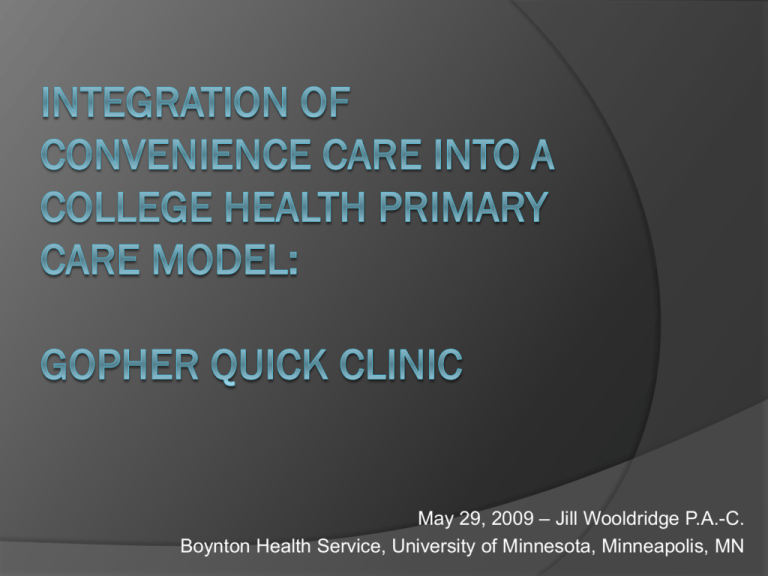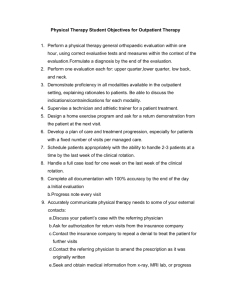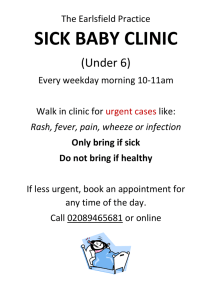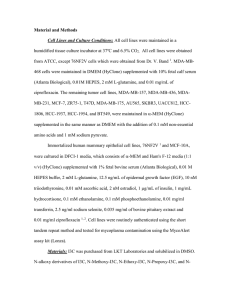presentation ( format)
advertisement

May 29, 2009 – Jill Wooldridge P.A.-C. Boynton Health Service, University of Minnesota, Minneapolis, MN Topics to be Covered: Define Convenience Care How we came to develop/improve Gopher Quick Clinic How Gopher Quick Clinic Functions Display data about utilization of GQC Impact on Providers, Primary Care, Urgent Care Financial Impact Future Considerations and Plans Challenges to the Model 2 “CONVENIENCE CARE” WHAT IS IT? Provides care for Minor Acute Illness (strep throat screens, bladder infections, sinus infections, warts, impetigo etc.), some basic vaccinations and basic testing. A Walk-in patient centered model usually staffed by Advance Practice Clinicians. Patients evaluate their own needs and pick care time that is convenient to their schedule. One Stop Care. Total patient interaction is in one location and usually a single face-to-face interaction with a single Clinician. Since the first Convenient Care clinics opened in 2000, the industry has grown quickly – today approximately 1,200 such clinics are in operation (many in retail locations) 3 HOW WAS THE BOYNTON PROJECT IDENTIFIED? An effort to support the University’s strategic mission to improve services to the student population. Community trends and patient expectations for more choice and control over how they access care – and Boynton’s and University Human Resources’ desire to meet these. An identified internal challenge in our current Urgent Care model to optimally serve acute care patients. 4 PURPOSE OF COMMITTEE October 10, 2006 - Committee charged by COO to evaluate: The benefits of providing a “Convenience Care” model of service. The appeal of “Convenience Care” to our patients and third-party payers. The impact of this service on Urgent and Primary Care. Over-all financial impact. 5 COMMITTEE MEMBERS Chair: Mary Alderman - Director Clinic Operations Co-chair: Dave Dorman – Health Promotion Beverly Carpenter – Administrative Assistant Joyce Fortier – Executive Secretary Jill Wooldridge, PA – Provider BJ Anderson, MD - Provider Britt Bakke - Marketing and New Program Development Paula Miller, RN – Student Health Advisory Committee member Barb Rangel, LPN – Supervisor Patient Assistance and Information Virginia Tranter, RN – Lead Nurse Immunization Clinic 6 QUALITY IMPROVEMENT PROCESS DMAIC: DMAIC is a basic component of the SixSigma methodology (Business Management Strategy) - a way to improve work processes by improving efficiency and eliminating defects. In its methodology, it asserts that in order to achieve high quality business processes, continued efforts must be made to reduce variations. 7 DMAIC MODEL DEFINE PHASE: What are the issues and desires for improvement MEASURE PHASE: Data collection to direct improvement efforts ANALYZE PHASE: Clarify and identify root cause of issue IMPROVE PHASE: List of all potential solutions and their impact with implementation plan and milestones CONTROL PHASE: Pilot plan, process control, implementation of solutions and transition control plan 8 Define Phase COLLECTING THE VOICE OF THE CUSTOMER o o o Conducted informal focus groups with the Student Health Advisory Committee (SHAC). Conducted informal focus groups with Boynton Health Service (BHS) staff: Providers, RNs, Pharmacy, Lab, Front Desk and Support staff. Created open message board for comments from BHS staff on shared network drive. 9 Measurement Phase Measured interest in a “Convenience Care” model • An online survey sent to 4,000 students, with a return rate of 32%, showed 68% were interested. • An online survey sent to 2,000 faculty and staff, with a return rate of 38%, showed 53% were interested. 10 Measurement Phase (continued) PROBLEM: Urgent Care process of dealing with Minor acute illness is inefficient and lengthy for the patient. Measured current process efficiency for treatment of minor acute illnesses in Urgent Care. Urgent Care Cycle-time study: Urgent Care Provider Average Cycle Time = 80.5 minutes RN Average Cycle Time = 54.5 minutes RUC Average Cycle Time = 66.0 minutes 11 Measurement Phase (continued) Reviewed 12-Month (9/05 - 8/06) Total MinuteClinic® Utilization U of M Student Benefit Plan (SBP) – 61 visits U of M Graduate Plan – 75 visits U of M Staff/Faculty Benefit Plans – 1,885 visits Of the total Staff/Faculty MinuteClinic® visits, 389 were seen at the Coffman site (just under 50/month). 12 Analyze Phase Analyzed results of student, staff and faculty online surveys. Reviewed list of factors identified in the formal focus groups. Performed a Root Cause analysis on current model of care. Consulted with Boynton Health Service Chief Operating Officer (COO) to examine fiscal implications of implementing a “Convenience Care” model. Toured the University of Minnesota Duluth QuickCare Clinic. 13 Improve Phase In March 2007 the Committee recommended that BHS provide a “Convenience Care” model service as a pilot, effective fall 2007. The service was named “Gopher Quick Clinic”. The hours of service were to be Monday through Friday , 9 a.m. to 5 p.m. with no coverage over the lunch hour (1-2pm). The service was not offered during holidays/breaks. Unless year-round fees were approved and a need for summer services was established, the service would not be offered during the summer. 14 GQC IMPLEMENTATION TEAM Chair: Mary Alderman - Director Clinic Operations Co-chair: Jill Wooldridge, PA – Provider Britt Bakke - Marketing and New Program Development Margaret Dahl, RN - Nurse Supervisor Primary Care Davin Hedin - Principal Accounts Specialist Sue Jackson - Director Student Health Benefit Plan Amy Murphy – Executive Accounts Specialist Barb Rangel, LPN – Supervisor Patient Assistance and Information Deb Sandberg, MD – Medical Director Karen Strauman-Raymond, RN – Nursing Director Gina Tran – Supervisor Patient Accounting 15 Improve Phase (continued) BHS Marketing Department implemented the “Marketing Plan” during spring and summer 2007. During March 2007 through August 2007 the Implementation Committee: • defined flow and location of clinic, • equipped and stocked the clinic, • hired Advanced Practice Clinician providers (to split time between primary care and GQC) • trained staff on new processes. On September 4, 2007 the new clinic service was opened. 16 Gopher Quick Clinic Services Gopher Quick Clinic is limited to addressing one of the following concerns per patient visit. Common Illnesses: Bladder Infection Bronchitis Cold/Cough Ear Infection Laryngitis Mononucleosis Respiratory Flu (without vomiting or diarrhea) Seasonal Allergies Sinus Infection Strep Throat Swimmer¹s Ear Skin Conditions: Athlete's Foot Cold Sores Impetigo Minor Sunburn Poison Ivy Ringworm Warts (three or fewer, does not include genital warts) Vaccines: Tetanus Vaccines (Td and Tdap) Flu Vaccine (when flu shot clinics not running) Additional Services Pregnancy Test 18 19 Boynton Gopher Quick Clinic 20 HOW DOES IT WORK? FRONT DESK STAFF: Checks in patient, “schedules” them for next available slot (every 15 minutes), tells patient approximate wait time, gives them Short Health History form to fill out. Handles any co-pay/insurance issues 21 22 23 24 HOW DOES IT WORK? GQC PROVIDER (Team of 6 PAs, 2 NPs): Calls patient from schedule on computer, brings back to room Interviews patient (uses paper form) Obtains vitals (Spot Vital Signs) Examines patient Performs any point-of-care labs [Strep, Mono, Flu, Urine dip, urine pregnancy test; Throat cultures, Urine cultures sent to lab] Writes any Rx, educates patient, uses pt. education materials Patient leaves room, provider finishes any documentation 25 Boynton Gopher Quick Clinic Exam Room 26 27 HOW DOES IT WORK? MEDICAL RECORDS: Collects paper encounter forms daily Sorts for billing, clinical record Scans the paper visit for our EMR (usually within 1 day) Abstracts pertinent data directly into our EMR: Reason for Visit, Vitals, Labs done, Assessment, Medications prescribed (usually within 1-2 days) 28 Control Phase (Fall 2007) The week of October 22-26, 2007 BHS sent a survey to all current Gopher Quick Clinic patients to assess satisfaction with the service. Katie Lust, PhD, Director of Research and Surveillance, evaluated all surveys 29 October 2007 Survey Results Compare Satisfied vs. Not so Satisfied Satisfied = Excellent, Very Good and Good Not so Satisfied = Fair and Poor 81.2% of the patients surveyed rated the entire visit as satisfactory. Target is 90% satisfaction rate. Patient concerns identified were: 1) wait time in the lobby 2) time spent with the provider in the exam room 3) privacy 30 OCTOBER SURVEY PROCESS IMPROVEMENT PLAN WAIT TIME : Added appointments over the 1-2 p.m. lunch time Changed marketing material to indicate that GQC was: 1) first-come-first serve and 2) capacity for the clinic may be reached prior to the 5 p.m. closing TIME SPENT WITH PROVIDER: Changed marketing material to say “Visits last approximately 10 minutes.” PRIVACY: • Performed a second survey asking more specific privacy questions • Changed location of urine sample drop-off from Lobby to Front Desk 31 Control Phase (Winter 2008) On January 22, 2008 BHS sent a 2nd survey to all current Gopher Quick Clinic patients to assess the following: Wait Time expectations Satisfaction with amount of time spent with the provider in the exam room Level of comfort with: 1) check-in procedure 2) location of waiting room 3) location of exam room Level of comfort with the process for giving a urine sample as it related to: 1) location of restroom 2) privacy of restroom 3) walking from restroom to drop-off box 4) location of drop-of box and overall urine collection procedure 32 JANUARY 2008 SURVEY RESULTS Compared Satisfied vs. Not so Satisfied Satisfied = Excellent, Very Good and Good Not so Satisfied = Fair and Poor 89.0% of the patients surveyed rated the entire visit as satisfactory. Target is 90%. Patient concerns identified were: 1) location of lobby in relation to exam room, 2) location of restroom in relation to drop-off box and 3) wait time 33 JANUARY SURVEY PROCESS IMPROVEMENT PLAN Exam Room Location: Moved exam room from off of Lobby to interior exam room within Primary Care South (PCS) Restroom and Drop-off Box Location: Changed restroom and drop-off box location to be within PCS clinic space Wait Time: Added second GQC provider in the PM. 34 35 Fall of 2008 – Opened Coffman Satellite Opportunity arose to utilize the Minute Clinic site across the street in the Union Hired 3 new staff to accommodate new fulltime GQC clinic and have back-up, as well as rotate into primary care to make the position more appealing. Front desk to be staffed from Patient Assistance Dept Challenging new workflow to get supplies, equipment (LN2), labs, etc. back and forth Set up remote access via computer as well Marketing! 36 37 38 39 COFFMAN GOPHER QUICK CLINIC Specific Challenges to the satellite site: Tried to make it as much like the original GQC as possible for provider staff and patients Had to set up courier drop off in AM, pick up in PM for supplies/labs Slightly more complicated transfer of patients to Urgent Care if needed – more hassle for patients Much less privacy, both in the “lobby” and the public restrooms Had to determine which site to close if providers are absent? 40 Visit Statistics for 2007-08 vs. 2008-09 Number of GQC Visits 2007-08 vs. 2008-09 7000 6000 Number of visits 5000 4000 3000 2000 1000 0 2007-08 GQC 2008-09 GQC Sept 477 852 Oct 584 977 Nov 493 871 Dec 294 589 Jan 326 503 Feb 565 875 March 479 854 Apr 569 938 YTD 3787 6459 41 42 Cycle Time Statistics for 2007-08 vs. 2008-09 250 198 200 162 150 138 126 100 50 36 25 18 11 37 37 29 11 0 Lobby Wait Time - Lobby Wait Time - Time with Provider - Time with Provider - Total Cycle Time - Total Cycle Time Avg. MAX Avg. MAX Avg. MAX 2007-08 2008-09 43 SUMMARY OF GQC STATISTICS (from previous slides) From 2007-08 to 2008-09, GQC visits from a comparable period increased from 3787 to 6459. Average total cycle time decreased from 37 to 29 minutes. Average wait time in the Lobby decreased from 25 to 18 minutes. Time with provider remained essentially constant. 44 NOVEMBER 2008 SURVEY RESULTS Compared Satisfied vs. Not so Satisfied Satisfied = Excellent, Very Good and Good Not so Satisfied = Fair and Poor Again, 89.0% of the patients surveyed rated the entire visit as satisfactory. Target is 90%. Issues identified were: 1) wait time satisfaction improved from Spring 08 2) Significant concerns regarding Privacy/Comfort at Coffman GQC, especially with regard to waiting area and urine sample collection 3) Patients who rated overall visit as fair or poor were expecting or would have liked to have more time with the provider 45 NOVEMBER ‘08 SURVEY PROCESS IMPROVEMENT PLAN Wait Time: Front Desk staff continue to offer Coffman as an option if the wait time is > 30 minutes at BHS Coffman Privacy/Comfort Concerns: In talks now with Coffman Building services about possible remodeling of the space to allow private waiting area. Unable to change restroom location. Expectations regarding time with provider: Make sure marketing materials and those encouraging the service are clear as to its limitations 46 IMPACT ON PROVIDERS Gopher Quick Clinic Providers Simple, easy visits? Or mind-numbingly boring after 25/day? Mix of GQC time with Family Practice is seen as a job satisfaction issue from a provider perspective, but results in possible “Excess Access” in clinic schedules Primary Care Providers Initial skepticism regarding continuity of care Concern over loss of quick visits that allow for “make-up” time for more involved visits. Perception that the complexity of visits has increased in Primary Care, though RVUs via coding has not yet borne that out. All agree “Quick” must not sacrifice “Quality” – evidencebased guidelines and judicious use of Antibiotics important 47 Top 20 Diagnoses for 2008-09 Gopher Quick Clinic Code Descr CountOfCode 462 ACUTE PHARYNGITIS 2,149 465.9 ACUTE URI NOS 1,815 599.0 URIN TRACT INFECTION NOS 811 461.9 ACUTE SINUSITIS NOS 617 078.10 VIRAL WARTS NOS 404 466.0 ACUTE BRONCHITIS 365 788.1 DYSURIA 249 463 ACUTE TONSILLITIS 244 477.9 ALLERGIC RHINITIS CAUSE UNSPECIFIED 207 034.0 STREP SORE THROAT 179 786.2 COUGH 152 382.00 AC SUPP OTITIS MEDIA NOS 150 381.4 NONSUPP OTITIS MEDIA NOS 131 V72.40 PREGNANCY EXAM/TEST UNCONFIRMED 82 V06.1 VACCIN FOR DTP 80 054.9 HERPES SIMPLEX NOS 78 075 INFECTIOUS MONONUCLEOSIS 69 380.10 INFEC OTITIS EXTERNA NOS 68 919.4 INSECT BITE NEC 62 381.81 DYSFUNCT EUSTACHIAN TUBE 58 48 IMPACT ON PRIMARY CARE VISITS Percent of minor acute illness was reduced from 18% to 15% Top 10 DX for 0607 Top 10 DX for 0708 Screen for Venereal Disease 1838 Screen for Venereal Disease 2236 Routine Medical Exam 1805 Routine Medical Exam 1725 Routine GYN Exam 1548 Routine GYN Exam 1427 Acute Pharyngitis 1517 Acute Pharyngitis 1024 Nonspecific Skin Eruption 833 Pap and Pelvic 1005 Viral Warts 715 Nonspecific Skin Eruption 745 Pap and Pelvic 710 Acne 604 Acne 594 Dysuria 585 Joint Pain – Ankle and Foot 538 Backache 513 Fatigue 538 Viral Warts 513 49 IMPACT ON URGENT CARE Percentage of visits for minor acute illness was reduced from 51% to 20%. Target was to reduce the percentage by 50%. Reduction of Minor Acute Illnesses in Urgent Care Total UC Provider Visits 6805 Total GQC Like Visit 6685 3822 3489 2683 760 51% 2006-07 Sept-May 40% 2007-08 Sept-May 20% 2008-09 Sept-Apr. 50 GOPHER QUICK CLINIC AND URGENT CARE VISITS ACADEMIC YEAR 0708 VS. ACADEMIC YEAR 0809 7000 6000 5000 4000 2007-08 GQC 2008-09 GQC 2007-08 UCC 3000 2008-09 UCC 2000 1000 0 Sept Oct Nov Dec Jan Feb March Apr YTD 51 SUMMARY OF CHANGE IN VISITS (from previous slides) GQC visits have continually increased in the same ratio as Urgent Care visits have fallen. Total GQC visits have increased. Total UC visits have decreased. Overall total visits to combined departments have increased. 52 Financial Impact: Visits and RVUs Department PRIMARY CARE URGENT CARE Visits (2006-07) 23,778 3,991 RVUs (2006-07) 51,240 9,665 RVUs per Visit 2.15 2.42 Department GOPHER QUICK CLINIC PRIMARY CARE URGENT CARE Visits (2007-08) 3,822 28,150 5,446 RVUs (2007-08) 5,971 60,659 11,608 RVUs per Visit 1.56 2.15 2.13 Department GOPHER QUICK CLINIC PRIMARY CARE URGENT CARE Visits (2008-09) 7,770 31,390 4,893 RVUs (2008-09) 13,273 64,752 10,534 RVUs per Visit 1.71 2.06 2.15 53 FINANCIAL MODELING GOPHER QUICK CLINIC Patients per Hour Average Office Revenue per Visit Average Ancillary Revenue per Visit * Revenue per Hour Average Provider Cost per Hour Nursing Support Cost per Hour Other Cost per Hour ** Total Cost per Hour Margin per Hour (full booking) PRIMARY CARE URGENT CARE 4 $63 $8 $284 3 $95 $15 $329 2 $119 $25 $287 $51 $0 $45 $96 $67 $23 $55 $145 $95 $63 $55 $214 $188 $184 $74 * Lab, Radiology, Pharmacy ** Facility, Med Rec, Billing, Admin, Misc 54 FINANCIAL ASPECTS The breakeven point for visits is three visits per hour. 55 CONCLUSIONS AND FUTURE CONSIDERATIONS 1. 2. 3. 4. 5. We have met our goal of an average cycle time of 30 minutes or less. We have met our goal of reducing the percentage of minor acute visits in Urgent Care by 50%. We have not met our goal of reaching an over-all satisfaction rate of 90% (but so close at 89%!). We need to balance access and/or services to remain financially sound. New Services? How to increase utilization of Coffman site? Anecdotally, there has been a slight shift in acuity in visits in Primary Care, requiring more people staying late. 56 Looking Forward – What‘s next? Remodel of Coffman Gopher Quick Clinic to allow for private waiting area Move another Gopher Quick Clinic into our St. Paul clinic for ½ day Monday-Friday. (Dropping 2nd PM provider at BHS) Looking at financial feasibility and/or profitability of adding some preventive services (Cholesterol screen, BP screen) 57 CHALLENGES to the CONVENIENCE CARE MODEL Balancing schedule – having back-up to remain open as advertised, but avoiding excess access Appropriateness (or not) of self-triage Repeat visits for same issue Higher acuity or complexity than GQC can handle, and subsequent “re-triage” of patients If desires of patient don’t fit GQC model (wanting more time, more than one concern, etc.) Getting all information into EMR in a timely way EMR wasn’t quick enough for pilot, but templates are in development that are more user-friendly, quick-templates – will still likely have to abstract some historical medical information H1N1 “Swine Flu”… 58 QUESTIONS?? jwooldridge@bhs.umn.edu Special Thanks to Mary Alderman, Director of Clinic Operations, and Carl Anderson, Chief Operations Officer! 59







